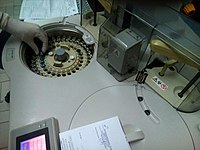
Photo from wikipedia
INTRODUCTION Sarcopenia is associated with significant cardiovascular risk, and death in patients undergoing peritoneal dialysis (PD). Three tools are used for diagnosing sarcopenia. The evaluation of muscle mass requires dual… Click to show full abstract
INTRODUCTION Sarcopenia is associated with significant cardiovascular risk, and death in patients undergoing peritoneal dialysis (PD). Three tools are used for diagnosing sarcopenia. The evaluation of muscle mass requires dual energy X-ray absorptiometry (DXA) or computed tomography (CT), which is labor-intensive and relatively expensive. This study aimed to use simple clinical information to develop a machine learning (ML)-based prediction model of PD sarcopenia. METHODS According to the newly revised Asian Working Group for Sarcopenia (AWGS2019), patients were subjected to complete sarcopenia screening, including appendicular skeletal muscle mass, grip strength, and five-time chair stand time test. Simple clinical information such as general information, dialysis-related indices, irisin and other laboratory indices, and bioelectrical impedance analysis (BIA) data were collected. All data were randomly split into training (70%) and testing (30%) sets. Difference, correlation, univariate, and multivariate analyses were used to identify core features significantly associated with PD sarcopenia. RESULT 12 core features (C), namely, grip strength, body mass index (BMI), total body water value, irisin, extracellular water/total body water, fat-free mass index, phase angle, albumin/globulin, blood phosphorus, total cholesterol, triglyceride, and prealbumin were excavated for model construction. Two ML models, the neural network (NN), and support vector machine (SVM) were selected with tenfold cross-validation to determine the optimal parameter. The C-SVM model showed a higher area under the curve (AUC) of 0.82 (95% confidence interval [CI]: 0.67-1.00), with a highest specificity of 0.96, sensitivity of 0.91, positive predictive value (PPV) of 0.96, and negative predictive value (NPV) of 0.91. CONCLUSION The ML model effectively predicted PD sarcopenia and has clinical potential to be used as a convenient sarcopenia screening tool.
Journal Title: Seminars in dialysis
Year Published: 2023
Link to full text (if available)
Share on Social Media: Sign Up to like & get
recommendations!